RH Bundle
How Did Restoration Hardware Transform into the Luxury Brand RH?
From its humble beginnings in 1979, RH, formerly Restoration Hardware, has carved a unique path in the luxury home furnishings market. The RH SWOT Analysis reveals the strategic shifts that propelled this transformation. This article dives into the fascinating RH Company history, exploring its evolution from a hardware-focused retailer to a lifestyle brand.
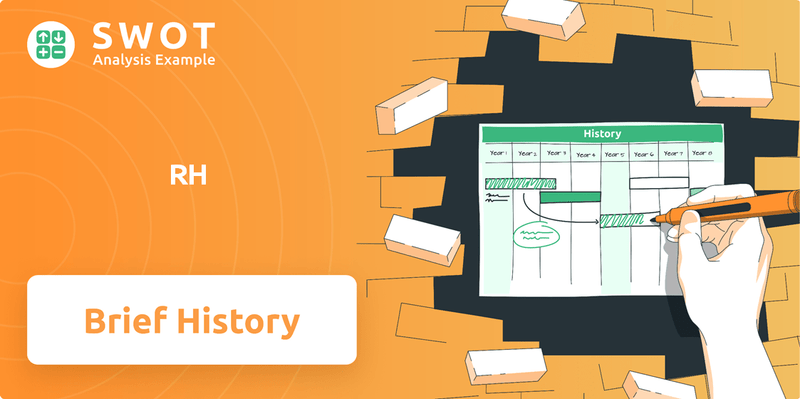
The RH brand story is one of remarkable adaptation and strategic vision, marked by pivotal moments and influential figures. Understanding the Restoration Hardware history provides valuable insights into its current market position and future potential. Explore the brief history of Restoration Hardware and discover how a simple vision grew into an industry leader.
What is the RH Founding Story?
The story of the RH Company, formerly known as Restoration Hardware, began on October 25, 1979. Stephen Gordon, the founder, launched the company in Eureka, California. His vision was to offer authentic, high-quality hardware for home restoration, a need he discovered while working on his own Victorian home.
The initial concept centered on selling vintage and reproduction hardware via a catalog. This approach targeted a growing market of homeowners interested in historical accuracy and fine craftsmanship. The name, Restoration Hardware, directly reflected this initial focus on restoration products. Early funding came from bootstrapping and personal investments.
The late 1970s provided a favorable environment for the establishment of RH. There was a rising interest in historic preservation and home improvement. This cultural context helped to lay the groundwork for the company's initial success. Learn more about the Marketing Strategy of RH.
The RH Company's history starts with a clear vision to provide quality hardware for home restoration.
- Founded in 1979 by Stephen Gordon in Eureka, California.
- Focused on selling vintage and reproduction hardware through a catalog.
- The name 'Restoration Hardware' reflected the initial business focus.
- Early funding came from bootstrapping and personal investments.
RH SWOT Analysis
- Complete SWOT Breakdown
- Fully Customizable
- Editable in Excel & Word
- Professional Formatting
- Investor-Ready Format
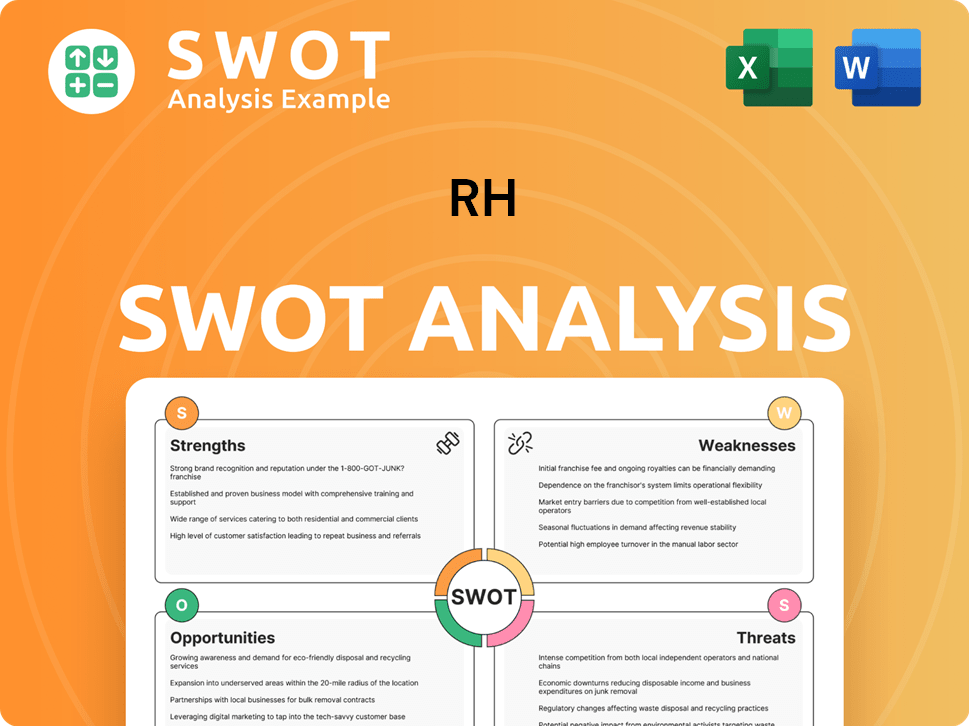
What Drove the Early Growth of RH?
The early years of RH Company, also known as Restoration Hardware, were marked by consistent growth. The company started by expanding its catalog beyond hardware, introducing home furnishings and decor. This strategic move set the stage for its future expansion and brand identity. The Growth Strategy of RH was a key factor.
A pivotal step in RH Company's early expansion was the opening of retail stores. This allowed customers to experience products firsthand, which was crucial for building brand recognition. By providing a physical presence, RH enhanced customer engagement and loyalty, setting it apart from purely catalog-based competitors. This strategy helped in establishing a strong market presence.
RH Company broadened its product categories significantly, venturing into furniture and textiles. This expansion dramatically increased its market reach and appeal. By offering a wider range of products, RH catered to a broader consumer base, solidifying its position in the home goods market. This diversification helped in driving sales and customer acquisition.
Key leadership transitions and strategic capital raises supported RH's growth. These investments enabled the company to invest in larger retail footprints and a more diverse inventory. Such financial backing was essential for scaling operations and meeting growing consumer demand. These strategic moves positioned RH for further expansion.
The market reception to RH's expansion was largely positive, with consumers seeking distinctive, high-quality home goods. The company filled a void in the market by offering products that transcended mass-market offerings. While competition existed, the niche RH carved out was less saturated, allowing for significant growth. In 2024, the luxury home furnishings market is estimated to be worth over $60 billion.
RH PESTLE Analysis
- Covers All 6 PESTLE Categories
- No Research Needed – Save Hours of Work
- Built by Experts, Trusted by Consultants
- Instant Download, Ready to Use
- 100% Editable, Fully Customizable
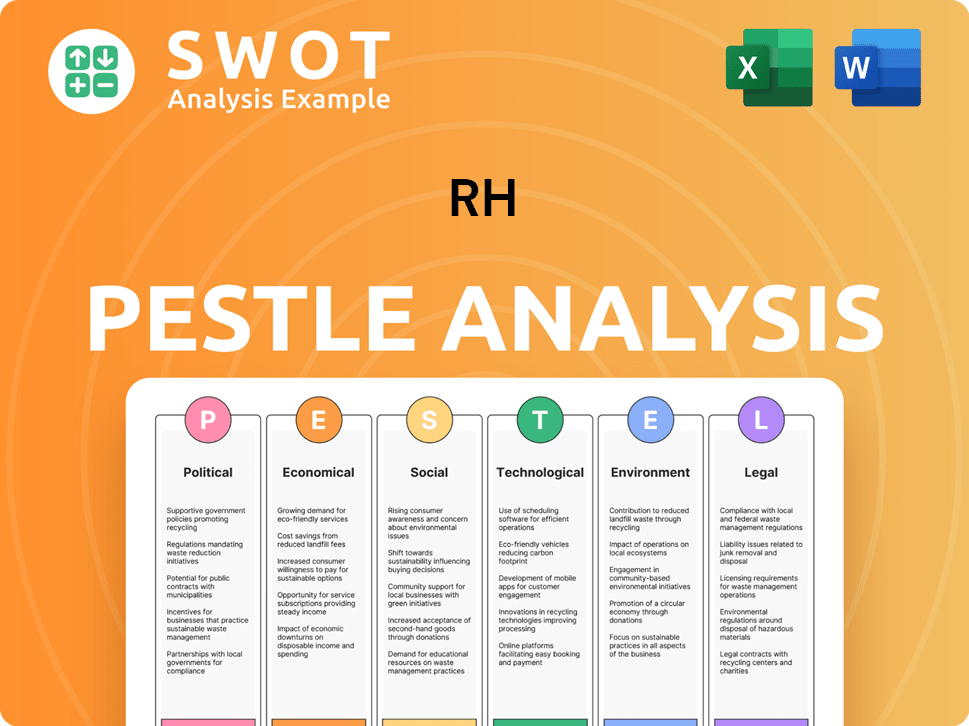
What are the key Milestones in RH history?
The RH Company history is marked by significant milestones that have shaped its journey in the luxury home furnishings market. From its early days to its current status as a leading brand, RH has navigated various phases of growth and transformation.
| Year | Milestone |
|---|---|
| 1979 | The company was founded, marking the beginning of Restoration Hardware. |
| 1990s | Expansion of retail locations and product lines, establishing a broader presence. |
| 2000s | Focus on design and branding, including the introduction of catalogs and enhanced store experiences. |
| 2012 | The company was rebranded as RH, signaling a shift towards a broader lifestyle brand. |
| 2010s-2020s | Continued expansion with new gallery concepts and international locations, alongside strategic partnerships. |
RH has been at the forefront of innovation in the retail sector, particularly with its unique approach to store design and customer experience. The 'gallery' concept, which transforms traditional retail spaces into immersive design destinations, is a prime example of its innovative spirit.
RH introduced its 'gallery' concept, creating immersive, multi-level design destinations that showcase its collections in inspiring settings. This approach revolutionized the way furniture was presented and sold, offering a unique customer experience.
RH has secured numerous patents for its unique designs, protecting its intellectual property and reinforcing its brand identity. These patents cover various aspects of its furniture and home decor products.
The company has leveraged catalogs and a strong digital presence to showcase its products and reach a wider audience. This multi-channel strategy has been key to its marketing efforts.
RH has formed partnerships with renowned designers and architects to enhance its product offerings and brand image. These collaborations bring fresh perspectives and expertise to its collections.
Despite its successes, RH has faced challenges, including economic downturns and increased competition in the luxury market. Navigating these pressures required strategic pivots and a constant focus on elevating the brand experience.
Economic recessions have impacted consumer spending on luxury goods, presenting challenges for RH. The company has had to adapt to changing market conditions and consumer behavior.
Competition from other high-end retailers and online disruptors has posed challenges to RH. The company has responded by focusing on its unique brand positioning and customer experience.
The major rebranding from Restoration Hardware to RH signaled a broader lifestyle focus. This shift aimed to expand the brand's appeal beyond just 'restoration' and capture a wider market.
The company has navigated internal crises and product failures, often through restructuring efforts and a relentless focus on elevating the brand experience. These experiences have refined RH's operational resilience.
RH Business Model Canvas
- Complete 9-Block Business Model Canvas
- Effortlessly Communicate Your Business Strategy
- Investor-Ready BMC Format
- 100% Editable and Customizable
- Clear and Structured Layout
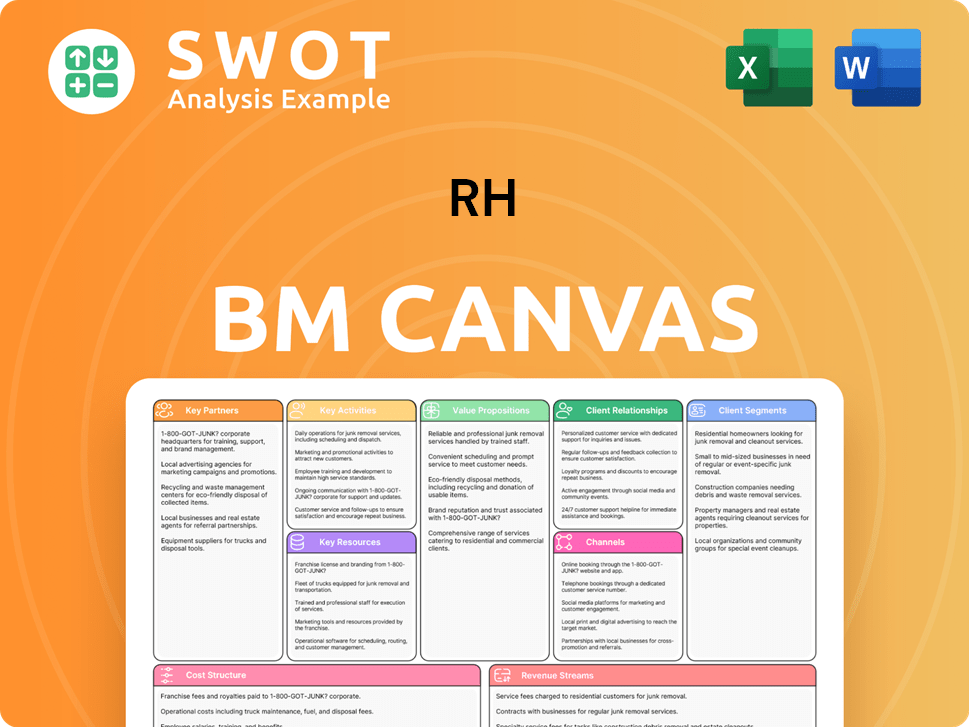
What is the Timeline of Key Events for RH?
The RH Company history is marked by strategic shifts and expansions. Stephen Gordon founded Restoration Hardware in 1979, and the company has since evolved from a catalog retailer to a global luxury brand. The journey includes going public, being taken private, and then returning to the public market, with significant changes in leadership and brand identity along the way. The company's focus has shifted from home furnishings to a broader lifestyle brand, including hospitality ventures and international expansion.
| Year | Key Event |
|---|---|
| 1979 | Stephen Gordon founded Restoration Hardware in Eureka, California. |
| 1980s | The company expanded its catalog offerings and opened its first retail stores. |
| 1998 | Restoration Hardware went public on the NASDAQ exchange. |
| 2001 | Gary Friedman joined as CEO, initiating a strategic transformation. |
| 2008 | The company was taken private in a leveraged buyout during the financial crisis. |
| 2012 | RH returned to the public market with an IPO. |
| 2012-2015 | Introduction of the 'gallery' retail concept and expansion into hospitality. |
| 2016 | Rebranding from Restoration Hardware to RH, signifying a broader lifestyle focus. |
| 2018 | Launch of RH Modern and RH Teen brands. |
| 2020s | Continued expansion of RH Guesthouses and international ventures. |
| 2024 | RH reported a net revenue of $775 million for the fourth quarter of fiscal year 2023, ending February 3, 2024. |
| 2025 | RH is expected to open its first international gallery in the UK, RH England, The Historic Estate, in Spring 2025. |
RH is focused on international growth, planning to open new galleries in Europe. RH England, The Historic Estate, is set to open in Spring 2025. RH Paris, The Gallery on Avenue Raymond Poincaré, is also planned for 2025. These moves mark a significant step in the company's global strategy.
The company aims to integrate its luxury hospitality ventures, such as RH Guesthouses. This integration strategy enhances the overall brand experience. The goal is to create a seamless connection between retail and hospitality offerings.
RH anticipates net revenues in the range of $3.04 billion to $3.14 billion for fiscal year 2024. This projection indicates continued financial growth for the company. The company's financial performance reflects its strategic initiatives.
Analysts predict continued growth driven by the company's unique brand positioning. Expansion into new markets is expected to be a key driver. The company's brand reputation supports its future success.
RH Porter's Five Forces Analysis
- Covers All 5 Competitive Forces in Detail
- Structured for Consultants, Students, and Founders
- 100% Editable in Microsoft Word & Excel
- Instant Digital Download – Use Immediately
- Compatible with Mac & PC – Fully Unlocked
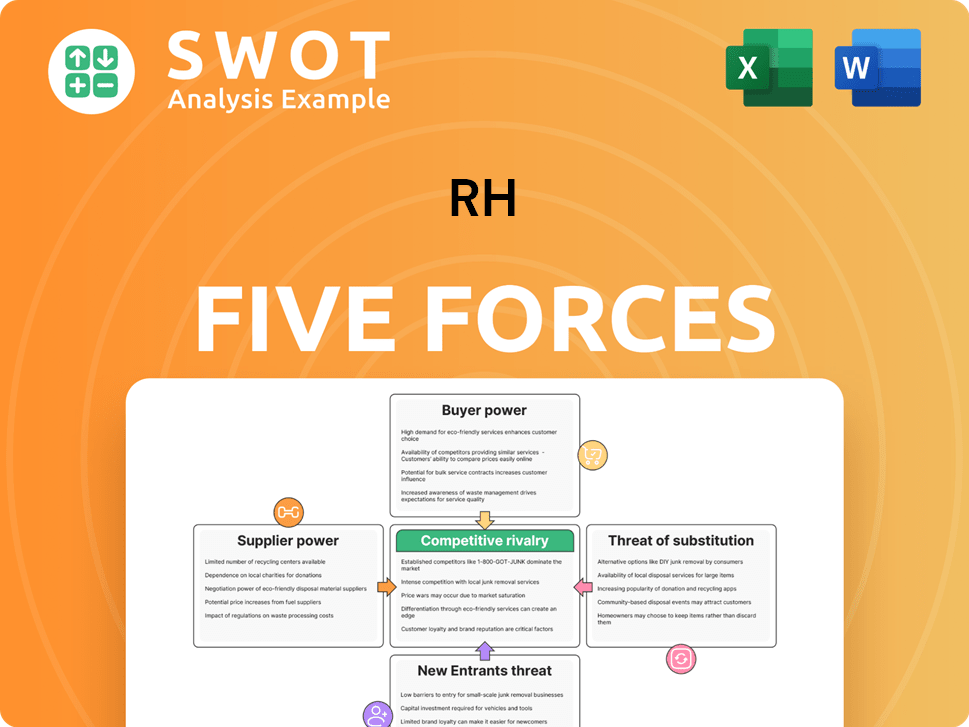
Related Blogs
Disclaimer
All information, articles, and product details provided on this website are for general informational and educational purposes only. We do not claim any ownership over, nor do we intend to infringe upon, any trademarks, copyrights, logos, brand names, or other intellectual property mentioned or depicted on this site. Such intellectual property remains the property of its respective owners, and any references here are made solely for identification or informational purposes, without implying any affiliation, endorsement, or partnership.
We make no representations or warranties, express or implied, regarding the accuracy, completeness, or suitability of any content or products presented. Nothing on this website should be construed as legal, tax, investment, financial, medical, or other professional advice. In addition, no part of this site—including articles or product references—constitutes a solicitation, recommendation, endorsement, advertisement, or offer to buy or sell any securities, franchises, or other financial instruments, particularly in jurisdictions where such activity would be unlawful.
All content is of a general nature and may not address the specific circumstances of any individual or entity. It is not a substitute for professional advice or services. Any actions you take based on the information provided here are strictly at your own risk. You accept full responsibility for any decisions or outcomes arising from your use of this website and agree to release us from any liability in connection with your use of, or reliance upon, the content or products found herein.